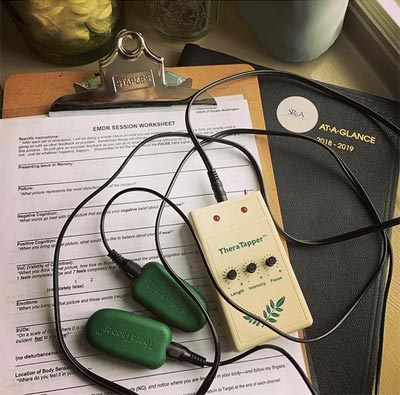
EMDR began 25 years ago as a therapy technique used to help relieve the pain associated with memories of major life traumas- the unexpected loss of a loved one, witnessing or being the victim of violence or extreme abuse, being involved in a terrible accident, or the experience of a major illness or medical crisis.
What is EMDR?
The EM stands for eye movement and in doing EMDR we would have the person focus on the disturbing memory while moving the eyes back and forth for a short while. We learned that the intensity of the memory would fade away and that reminders of the memory would no longer bring up disturbing feelings and thoughts. We didn’t understand the brain mechanisms involved but years of subsequent study on how the brain works have taught us how this works and how to use the brain in other ways to help relieve suffering. Hundreds of thousands of therapists have been trained in EMDR in the years since and we have learned how to work with memories to help people overcome fears, anxieties, unwanted urges, and extreme reactions to others. We have learned that it is not just major life traumas that can affect how we think and feel in the present but that even apparently insignificant memories of discomfort can lead to present day difficulties. With EMDR therapy, people can become steadier and begin to experience more joy, interest, and excitement in their day to day life.
Because EMDR involves bringing up and focusing on disturbing memories, you can expect to feel some discomfort during the initial part of the process but when we begin to stimulate the brain with eye movement or other kinds of bilateral stimulation such as auditory or tactile, you will begin to notice some relief until eventually the memory will no longer bother you. In addition, you will come to better understand what happened. This is what we call reprocessing- when the disturbance associated with the memory begins to fade, the brain begins to sort out the meaning of the experience in order to learn from it and to consider how to handle the situation differently if something similar should happen in the future. EMDR is not a Talk Therapy. While the EMDR therapist does talk with you to better understand your concerns, the therapist will be working with you to identify the kinds of life experiences you have had that contribute to your present discomfort. The EMDR therapist seeks to understand better how your brain’s memory system works. Each brain is different and handles memories differently. Real change will come not just from talking about experiences but in reliving the experiences in the present in such a way that the experience can be reprocessed by the brain. In EMDR reprocessing, your brain does the work while the therapist guides the process. This involves very little talk.
The therapist might help prepare you for memory reprocessing by working with you to expand your range of skills in managing uncomfortable emotional states. Your therapist might also work with you to strengthen other memory networks in the brain to help increase your experience of desirable emotional states such as peace, contentment, love, interest, and curiosity. You and your therapist will decide together when to begin the reprocessing of disturbing memories.
In doing EMDR, it is vital that you tell your therapist anytime you are beginning to have doubts, concerns, or emotional reactions to the therapist. These experiences are often connected to other experiences and memories stored in your brain. When you share your thoughts and feelings about the therapy and the therapist in the moment, you will be better able to get to the earlier memory networks that need to be reprocessed. Getting to the early memories, what we call touchstone memories, is often very challenging as they are stored in compartments that can be tough to reach. Sharing your present uncomfortable experience of the therapist and the therapy can make it possible to access these early compartmentalized memory networks and can allow for deeper change to take place.
Thanks to Dan Merlis at www.emdrgreaterwashington.com for this content.

